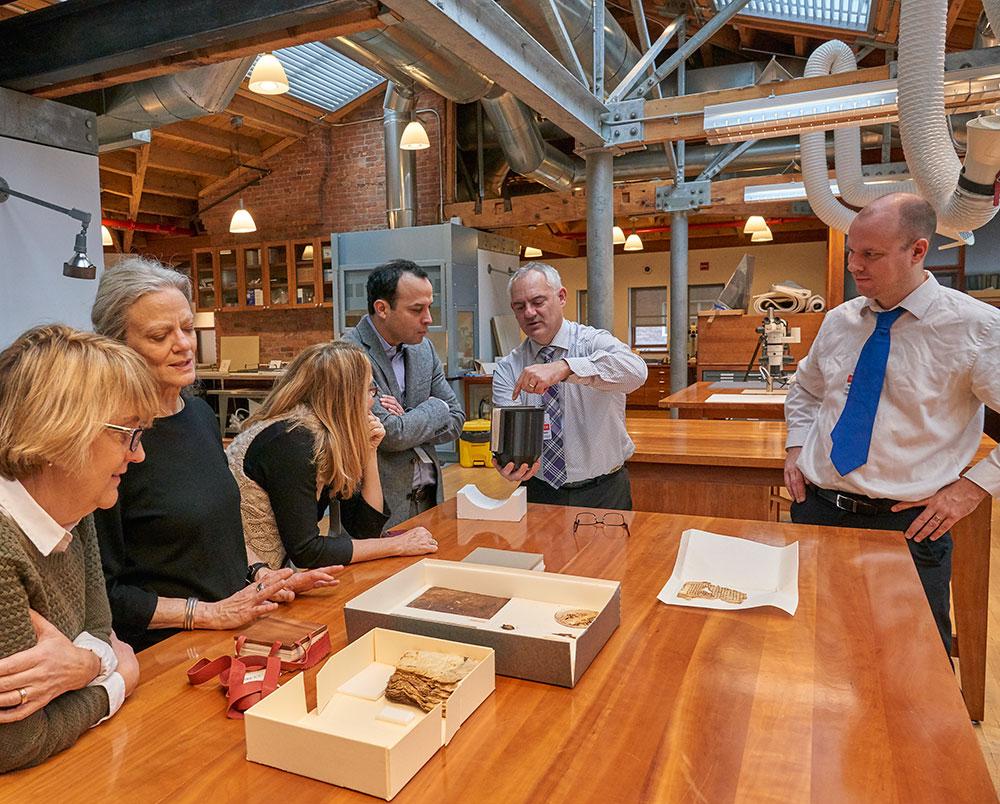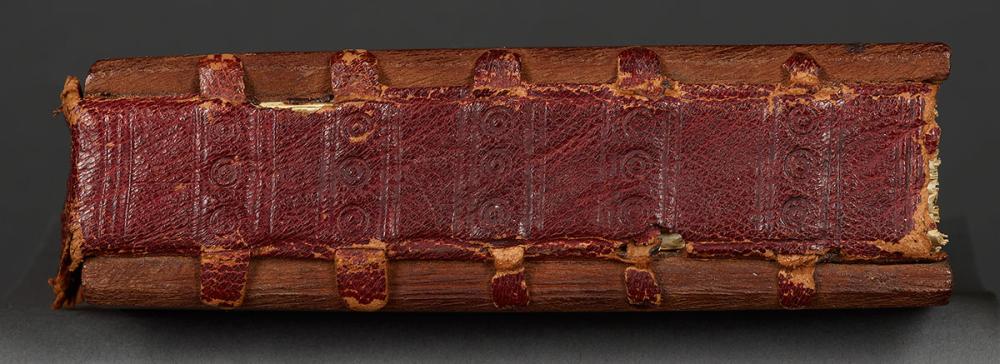The Morgan’s collection includes a significant number of Coptic Christian manuscripts made in Egypt and dating from the fifth through the eleventh centuries. The Coptic collection is notable for its texts and illuminations as well as for a large group of early covers and binding fragments important in the history of bookbinding.
One of the earliest of these is the fifth century Glazier Codex (MS G.67), a small-format Acts of the Apostles in remarkably good condition in spite of its age. Apart from some losses around the edges, the parchment leaves appear almost pristine, as do the inks and lettering (Figures 1, 2). The book retains most of its original binding components in a fragile but nearly intact state, including a characteristic link-stitch sewing (Figure 3), a leather spine piece, acacia-wood cover boards, and leather wrapping straps with bone anchoring pegs (Figure 6a). Only a small number of texts and bindings from this period of codex book production survive, and each contributes to our understanding of the cultures and craft traditions that produced them.
1

Figure 2: MS G.67 Acts of the Apostles. Center of a quire,2 showing the sewing thread inside the fold. The text is written in the Oxyrhynchite Coptic dialect, using Greek uncial script with some Coptic characters.

Figure 3: Several forms of link-stitch sewing as seen on the spine folds of a bound book. Variations of this sewing are found throughout the history of bookbinding, but it was universally used in the Mediterranean region from late antiquity through the eighth or ninth century.3 (Reproduced from Szirmai, The Archaeology of Medieval Bookbinding 1999.)
A second Coptic Acts of similar age and size, MS M.910, has fared less well than its Glazier cousin, having been severely damaged by both fire and water sometime before 1962 when it was acquired by the Morgan. The parchment is charred, tattered, gelatinized, and brittle in many areas; some leaves are so distorted that they are actually interlocked, making it impossible to open the book without causing more damage and loss. Catalyzed by exposure to moisture, the iron-gall ink used to write the manuscript has corroded in certain places, and this in turn is causing local perforation of the parchment support (Figure 4).
While it is known that this text is an Acts of the Apostles written in the Sahidic dialect, modern scholars of Coptic Christianity and other Mediterranean religions have sought to know whether M.910 contains significant textual variants or even additional texts. Unfortunately, its physical condition has made full access to the text impossible. On the material side, fragments of the original binding (wood boards, leather spine piece, carved bone peg) that remain with the book indicate a close relationship with the binding of the Glazier Codex and are thus quite significant in themselves (Figures 6b, 6c). The link-stitch sewing is visible on the spine (Figure 5) and largely intact within the book block, but as in the text, important details have been impossible to see and understand.
Figure 6a–c: Modern replica of the Glazier Codex binding (left) held closed with wrapping straps and bone pegs; the binding fragments belonging to MS M.910, center and right, show evidence of similar features.
In 2017, book conservators at the Morgan embarked on a project with Brent Seales, Professor of Computer Science at the University of Kentucky and director of the Digital Restoration Initiative, and Paul Dilley, Associate Professor of Ancient Mediterranean Religions at the University of Iowa, to see whether non-destructive imaging techniques could uncover hidden text and sewing details.4 Seales and his team have been involved in a number of projects using X-ray microtomography, or micro-CT scanning, to reveal texts made inaccessible by damage or age; one of their most notable projects has been the ‘virtual unrolling’ of a carbonized scroll from the En-Gedi archaeological site.5

Figure 7: Morgan book conservators Maria Fredericks (second from left) and Frank Trujillo (fourth from left) discuss the micro-CT scanning process with Brent Seales and other team members in the Thaw Conservation Center. Paul Dilley, Associate Professor of Ancient Mediterranean Religions, University of Iowa, is on the right.
The micro-CT scanner6 produces thousands of cross-sectional X-ray images, each one captured on a slightly different axis through the artifact; the object to be scanned is placed on a rotating stage, which moves at fixed increments every few seconds until sufficient data is captured. Working closely with the Morgan’s conservators, the University of Kentucky team created a special 3D-printed mount to hold the manuscript securely without applying pressure to the fragile parchment leaves. Test scans were conducted on a mock-up of the manuscript created by Melissa Moreton, Mellon Sawyer Postdoctoral Fellow at the University of Iowa.7
As in a standard medical X-ray, micro-CT scans show dense materials as brighter areas within an image, relative to materials that are less dense. Metals are often opaque to X-rays and can show very brightly indeed. In the case of M.910, the iron content in the ink produces bright spots on the images, marking where each cross-section intersects the work of the Coptic scribe (Figure 9).
After imaging, complex data processing digitally flattens each leaf and re-assembles the text into legible form (Figure 10). This virtual unwrapping process uses the different density measurements in the X-rays to map the locations of the ink. A machine-learning tool known as a neural network ‘teaches’ the software to differentiate between the ink and the surface of the parchment. The presence of writing on both sides of M.910’s extraordinarily thin parchment (just .13 mm in locations accessible for measuring) as well as the serpentine distortions of many leaves, makes this process especially challenging. At the time of writing, the work is still ongoing, but results to date are quite promising. The text fragment below has been identified by Paul Dilley as a passage from Acts 10:4–6.
The micro-CT scans also produced some new information about the binding, making it possible to visualize the quire makeup, the thread pathways, and even the structure of the thread itself. Cross-sectional images and videos reveal that each quire is made up of eight leaves, or four folded sheets nested together; each sewing thread is made up of three thinner strands twisted together in a Z-twist, or counterclockwise, direction. (Details such as the twist direction can help differentiate between otherwise similar threads.)
Figure 11/Video 1: This video follows a cross-sectional path along the spine of the book from head to tail. Each quire is made up of four folded sheets of thin parchment; the sewing threads appear as round, rotating forms inside the center folds as the video plays. The apparent rotation is due to the twisted 3-ply structure of the thread, which follows a counterclockwise, or Z-twist, path.
Figure 12/Video 2: Another cross-sectional view of the spine, showing the exterior of the folds and the formation of the link-stitch sewing.
The opportunity to collaborate across disciplines is one of the most exciting and rewarding aspects of a conservator’s work and sometimes provides a way forward on persistent problems or challenges. For many years, the desire for scholarly access to M.910’s hidden texts, as well as the binding historian’s curiosity about internal physical details, appeared to be at odds with the preservation of crucial material evidence. With the advent of advanced non-invasive imaging technologies, and digital humanities initiatives at cultural institutions worldwide, agendas for preservation and access can be more closely aligned.
To learn more about conservation research and collaborations at the Morgan, visit the Thaw Conservation Center’s web page and blog or view these virtual lectures on the Morgan’s website:
- The Black Hours at the Morgan Library & Museum
- The Drawings of Al Taylor: Perspectives from a Curator and a Conservator
With many thanks to Brent Seales, Christy Chapman, Kristina Gessen, and Seth Parker, University of Kentucky; Paul Dilley and Melissa Moreton, University of Iowa; Microphotonics, Inc.; Frank Trujillo, Xiaoping Cai, John Alexander, Kristina Stillman, and Linden Chubin, the Morgan Library & Museum.
Images:
Graham Haber, figures 1, 2, 6b, 6c, 7; Maria Fredericks, figures 4, 5, 6a; Nicole Craine for The New York Times, figure 8; University of Kentucky/Digital Restoration Initiative, figures 9, 10, 11, 12.
End notes
- For an in-depth discussion of the history and significance of the Morgan’s Coptic bindings, watch this lecture by Frank Trujillo, Drue Heinz Book Conservator in the Morgan’s Thaw Conservation Center, presented at Early Codices: Production, Destruction and Modern Conservation, Bard Graduate Center 2018. This symposium accompanied The Codex and Crafts in Late Antiquity, curated by Georgios Boudalis.
- A quire (also called a gathering or section) consists of one or more folded sheets that are sewn together to make up a bound volume or codex. Single- as well as multi-quire books have existed since late antiquity.
- For more information on the early history of this sewing, see Boudalis, The Codex and Crafts in Late Antiquity, 2018.
- Scanning an Ancient Biblical Text That Humans Fear to Open, The New York Times
- Modern Technology Unlocks Secrets of a Damaged Biblical Scroll, The New York Times
- Equipment used for this project was a Bruker Skyscan 1173 provided by Micro Photonics, Inc.
- Read Melissa’s blog post on this historical re-creation here.
Maria Fredericks
Sherman Fairchild Head of the Thaw Conservation Center
The Morgan Library & Museum









